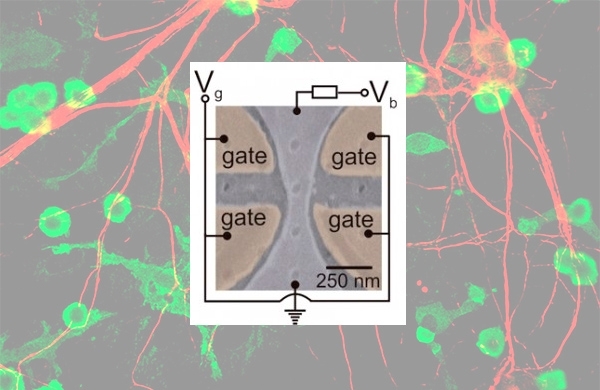

Device stores information in its own structure, dispensing with the need for a complementary memory unit. Architecture can be used as platform for fabrication of super-compact counters or calculators
Device stores information in its own structure, dispensing with the need for a complementary memory unit. Architecture can be used as platform for fabrication of super-compact counters or calculators.
Device stores information in its own structure, dispensing with the need for a complementary memory unit. Architecture can be used as platform for fabrication of super-compact counters or calculators.

Device stores information in its own structure, dispensing with the need for a complementary memory unit. Architecture can be used as platform for fabrication of super-compact counters or calculators
By José Tadeu Arantes | Agência FAPESP – A transistor that simulates some of the functions of neurons has been invented based on experiments and models developed by researchers at the Federal University of São Carlos (UFSCar) in São Paulo State, Brazil, Würzburg University in Germany, and the University of South Carolina in the United States.
The device, which has micrometric as well as nanometric parts, can see light, count, and store information in its own structure, dispensing with the need for a complementary memory unit.
It is described in the article “Nanoscale tipping bucket effect in a quantum dot transistor-based counter”, published in the journal Nano Letters. The research was supported by FAPESP through the projects “Transport properties and quantum computation in nanostructures”, “Network for nano-optics and nano-electronics”, and “Optical and transport phenomena in nanodevices”.
“In this article, we show that transistors based on quantum dots can perform complex operations directly in memory. This can lead to the development of new kinds of device and computer circuit in which memory units are combined with logical processing units, economizing space, time, and power consumption,” said Victor Lopez Richard, a professor in UFSCar’s Physics Department and one of the coordinators of the study.
The transistor was produced by a technique called epitaxial growth, which consists of coating a crystal substrate with thin film. On this microscopic substrate, nanoscopic droplets of indium arsenide act as quantum dots, confining electrons in quantized states. Memory functionality is derived from the dynamics of electrical charging and discharging of the quantum dots, creating current patterns with periodicities that are modulated by the voltage applied to the transistor’s gates or the light absorbed by the quantum dots.
“The key feature of our device is its intrinsic memory stored as an electric charge inside the quantum dots,” Richard said. “The challenge is to control the dynamics of these charges so that the transistor can manifest different states. Its functionality consists of the ability to count, memorize, and perform the simple arithmetic operations normally done by calculators, but using incomparably less space, time, and power.”
According to Richard, the transistor is not likely to be used in quantum computing because this requires other quantum effects, such as entanglement, which occurs when pairs or groups of particles are generated or interact in such a way that the quantum state of each particle cannot be described independently but depends on both or all of the particles, however far apart they may be.
However, it could lead to the development of a platform for use in equipment such as counters or calculators, with memory intrinsically linked to the transistor itself and all functions available in the same system at the nanometric scale, with no need for a separate space for storage.
“Moreover, you could say the transistor can see light because quantum dots are sensitive to photons,” Richard said, “and just like electric voltage, the dynamics of the charging and discharging of quantum dots can be controlled via the absorption of photons, simulating synaptic responses and some functions of neurons.”
Further research will be necessary before the transistor can be used as a technological resource. For now, it works only at extremely low temperatures – approximately 4 Kelvin, the temperature of liquid helium.
“Our goal is to make it functional at higher temperatures and even at room temperature. To do that, we’ll have to find a way to separate the electronic spaces of the system sufficiently to prevent them from being affected by temperature. We need more refined control of synthesis and material growth techniques in order to fine-tune the charging and discharging channels. And the states stored in the quantum dots have to be quantized,” Richard said.
Republish
The Agency FAPESP licenses news via Creative Commons (CC-BY-NC-ND) so that they can be republished free of charge and in a simple way by other digital or printed vehicles. Agência FAPESP must be credited as the source of the content being republished and the name of the reporter (if any) must be attributed. Using the HMTL button below allows compliance with these rules, detailed in Digital Republishing Policy FAPESP.





